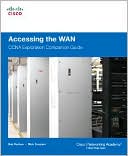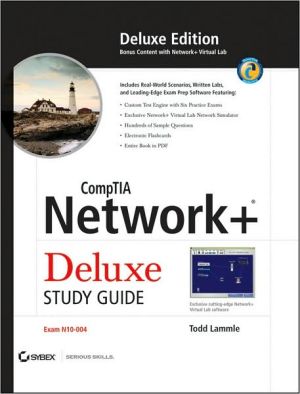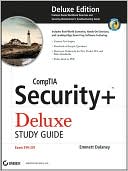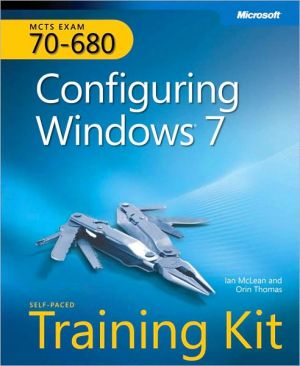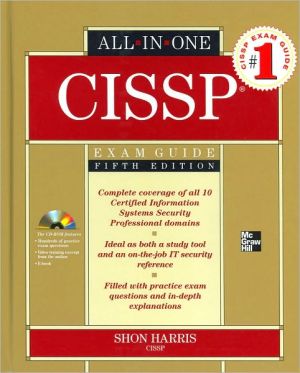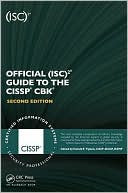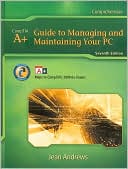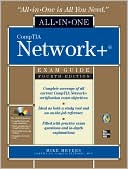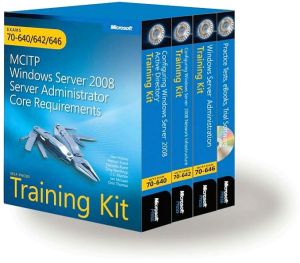Accessing the WAN: CCNA Exploration Companion Guide
Search in google:
Accessing the WANCCNA Exploration Companion GuideBob VachonRick GrazianiAccessing the WAN, CCNA Exploration Companion Guide is the official supplemental textbook for the Accessing the WAN course in the Cisco Networking Academy CCNA Exploration curriculum version 4. This course discusses the WAN technologies and network services required by converged applications in enterprise networks. The Companion Guide, written and edited by Networking Academy instructors, is designed as a portable desk reference to use anytime, anywhere. The book’s features reinforce the material in the course to help you focus on important concepts and organize your study time for exams.New and improved features help you study and succeed in this course: Chapter objectives: Review core concepts by answering the focus questions listed at the beginning of each chapter. Key terms: Refer to the updated lists of networking vocabulary introduced and turn to the highlighted terms in context in each chapter. Glossary: Consult the all-new comprehensive glossary with more than 250 terms. Check Your Understanding questions and answer key: Evaluate your readiness with the updated end-of-chapter questions that match the style of questions you see on the online course quizzes. The answer key explains each answer. Challenge questions and activities: Strive to ace more challenging review questions and activities designed to prepare you for the complex styles of questions you might see on the CCNA exam. The answer key explains each answer.Bob Vachon is the coordinator of the Computer Systems Technology program and teaches networking infrastructure courses at Cambrian College in Sudbury, Ontario, Canada. Bob has worked and taught in the computer networking and information technology field for 25 years and is a scholar graduate of Cambrian College.Rick Graziani teaches computer science and computer networking courses at Cabrillo College in Aptos, California. Rick has worked and taught in the computer networking and information technology field for 30 years.How To: Look for this icon to study the steps that you need to learn to perform certain tasks.Packet Tracer Activities: Explore networking concepts in activities interspersed throughout some chapters usingPacket Tracer v4.1 developed by Cisco. The files for these activities are on the accompanying CD-ROM.Also available for the Accessing the WAN CourseAccessing the WAN,CCNA ExplorationLabs and Study GuideISBN-10: 1-58713-201-XISBN-13: 978-1-58713-201-8Companion CD-ROMThe CD-ROM provides many useful tools and information to support your education:Packet Tracer Activity exercise files A Guide to Using a Networker’s Journal booklet Taking Notes: A .txt file of the chapter objectives More IT Career Information Tips on Lifelong Learning in NetworkingThis book is part of the Cisco Networking Academy Series from Cisco Press. The products in this series support and complement the Cisco Networking Academy online curriculum.
Chapter 1 Introduction to WANs 1Objectives 1Key Terms 1Introducing Wide-Area Networks (WANs) 3What Is a WAN? 3Why Are WANs Necessary? 5The Evolving Enterprise 5Businesses and Their Networks 5Small Office (Single LAN) 6Campus (Multiple LANs) 6Branch (WAN) 8Distributed (Global) 9The Evolving Network Model 11The Hierarchical Design Model 11The Enterprise Architecture 13WAN Technology Concepts 17WAN Technology Overview 17WAN Physical Layer Concepts 18WAN Data Link Layer Concepts 23WAN Switching Concepts 26WAN Connection Options 29WAN Link Connection Options 29Dedicated Connection Link Options 31Circuit-Switched Connection Options 32Packet-Switched Connection Options 35I nternet Connection Options 38Choosing a WAN Link Connection 44Summary 48Labs 49Check Your Understanding 50Challenge Questions and Activities 54Chapter 2 PPP 55Objectives 55Key Terms 55Introducing Serial Communications 56How Does Serial Communication Work? 56Serial Communication Standards 59TDM 61Demarcation Point 66Data Terminal Equipment and Data Communications Equipment 67HDLC Encapsulation 72Configuring HDLC Encapsulation 75Troubleshooting Serial Interfaces 76PPP Concepts 83Introducing PPP 83PPP Layered Architecture 84PPP Frame Structure 87Establishing a PPP Session 88Establishing a Link with LCP 89NCP Explained 95PPP Configuration Options 97PPP Configuration Commands 98Verifying a Serial PPP Encapsulation Configuration 101Troubleshooting PPP Encapsulation 102PPP Authentication Protocols 108Password Authentication Protocol 109Challenge Handshake Authentication Protocol (CHAP) 110PPP Encapsulation and Authentication Process 112Configuring PPP with Authentication 115Troubleshooting a PPP Configuration with Authentication 118Summary 120Labs 120Check Your Understanding 122Challenge Questions and Activities 126Chapter 3 Frame Relay 127Objectives 127Key Terms 127Introduction 128Basic Frame Relay Concepts 128Introducing Frame Relay 128Virtual Circuits 134Frame Relay Encapsulation 140Frame Relay Topologies 141Frame Relay Address Mapping 145Configuring Frame Relay 152Enabling Frame Relay Encapsulation 153Configuring Static Frame Relay Maps 156Advanced Frame Relay Concepts 159Solving Reachability Issues 159Frame Relay Subinterfaces 161Paying for Frame Relay 162Frame Relay Flow Control 166Configuring Advanced Frame Relay 168Configuring Frame Relay Subinterfaces 168Verifying Frame Relay Operation 171Troubleshooting Frame Relay Configuration 178Summary 180Labs 181Check Your Understanding 182Challenge Questions and Activities 188To Learn More 188Chapter 4 Network Security 189Objectives 189Key Terms 189Introduction to Network Security 190Why Is Network Security Important? 190Common Security Threats 199Types of Network Attacks 206General Mitigation Techniques 219The Network Security Wheel 226The Enterprise Security Policy 229Securing Cisco Routers 232Router Security Issues 232Applying Cisco IOS Security Features to Routers 235Securing Router Network Services 250Vulnerable Router Services and Interfaces 250Securing Routing Protocols 256Locking Down Your Router with Cisco AutoSecure 263Using Cisco SDM 264Cisco SDM Overview 264Configuring Your Router to Support SDM 265Starting SDM 267The SDM Interface 269Cisco SDM Wizards 272Locking Down a Router with SDM 272Secure Router Management 275Maintaining Cisco IOS Software Images 275Managing Cisco IOS Images 276Managing Cisco IOS Images 283Backing Up and Upgrading a Software Image 284Recovering Software Images 288Troubleshooting Cisco IOS Configurations 294Recovering a Lost Password 297Summary 301Labs 301Check Your Understanding 302Challenge Questions and Activities 308Chapter 5 ACLs 309Objectives 309Key Terms 309Using ACLs to Secure Networks 310A TCP Conversation 310Packet Filtering 313What Is an ACL? 316ACL Operation 318Types of Cisco ACLs 322How a Standard ACL Works 323Numbering and Naming ACLs 323Where to Place ACLs 324General Guidelines for Creating ACLs 327Configuring Standard ACLs 327Entering Criteria Statements 327Configuring a Standard ACL 328ACL Wildcard Masking 332Applying Standard ACLs to Interfaces 339Editing Numbered ACLs 343Creating Standard Named ACLs 345Monitoring and Verifying ACLs 346Editing Named ACLs 347Configuring an Extended ACL 348Extended ACLs 349Configuring Extended ACLs 351Applying Extended ACLs to the Interfaces 353Creating Named Extended ACLs 355Configure Complex ACLs 357What Are Complex ACLs? 357Dynamic ACLs 358Reflexive ACLs 360Time-Based ACLs 363Troubleshooting Common ACL Errors 364Summary 368Labs 368Check Your Understanding 369Challenge Questions and Activities 375Chapter 6 Teleworker Services 377Objectives 377Key Terms 377Business Requirements for Teleworker Services 379The Business Requirements for Teleworker Services 379The Teleworker Solution 380Broadband Services 384Connecting Teleworkers to the WAN 384Cable 385DSL 391Broadband Wireless 396VPN Technology 401VPNs and Their Benefits 402Types of VPNs 405VPN Components 407Characteristics of Secure VPNs 408VPN Tunneling 409VPN Data Confidentiality and Integrity 410IPsec Security Protocols 416Summary 419Labs 419Check Your Understanding 419Challenge Questions and Activities 423Chapter 7 IP Addressing Services 429Objectives 429Key Terms 429Introduction 431DHCP 431Introduction to DHCP 432DHCP Operation 432BOOTP and DHCP 435Configuring a Cisco Router as a DHCP Server 440Configuring a DHCP Client 447DHCP Relay 449Configuring a DHCP Server Using SDM 453Troubleshooting DHCP Configuration 456Scaling Networks with NAT 460What Is NAT? 462Benefits and Drawbacks of Using NAT 468Configuring Static NAT 470Configuring Dynamic NAT 471Configuring NAT Overload for a Single Public IP Address 473Configuring NAT Overload for a Pool of Public IP Addresses 475Configuring Port Forwarding 477Verifying NAT and NAT Overload 479Troubleshooting NAT and NAT Overload Configuration 483IPv6 485Reasons for Using IPv6 489IPv6 Addressing 493IPv6 Transition Strategies 499Cisco IOS Dual Stack 500IPv6 Tunneling 502Routing Configurations with IPv6 503Configuring IPv6 Addresses 506Configuring RIPng with IPv6 508Summary 512Labs 512Check Your Understanding 514Challenge Questions and Activities 522Chapter 8 Network Troubleshooting 525Objectives 525Key Terms 525Establishing the Network Performance Baseline 526Documenting Your Network 526Network Documentation Process 533Why Is Establishing a Network Baseline Important? 535Steps for Establishing a Network Baseline 535Troubleshooting Methodologies and Tools 541A General Approach to Troubleshooting 541Using Layered Models for Troubleshooting 541General Troubleshooting Procedures 544Troubleshooting Methods 545Gathering Symptoms 548Troubleshooting Tools 551Review of WAN Communications 560WAN Communications 560Steps in WAN Design 561WAN Traffic Considerations 562WAN Topology Considerations 564WAN Connection Technologies 567WAN Bandwidth Considerations 568Common WAN Implementations Issues 569WAN Troubleshooting from an ISP’s Perspective 570Network Troubleshooting 571Physical Layer Troubleshooting 573Data Link Layer Troubleshooting 577Network Layer Troubleshooting 584Transport Layer Troubleshooting 586Application Layer Troubleshooting 589Summary 595Labs 595Check Your Understanding 596Challenge Questions and Activities 600Appendix 601Glossary 637
